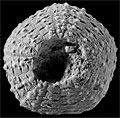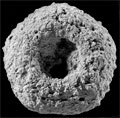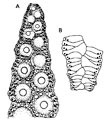The Echinoid Directory
Contributed by Andrew Smith, August 2011
Glyptocyphus Pomel, 1883, p. 87
| Diagnostic Features |
|
|---|---|
| Distribution | Mid Cretaceous (Albian - Cenomanian), western Europe |
| Name gender | masculine |
| Type | Cyphosoma difficilis Agassiz, in Agassiz & Desor, 1846, p. 352, by subsequent designation of Lambert & Thiery (1911, p. 219). |
| Species Included | Only the type species. |
| Classification and/or Status | Camarodonta, Glyphocyphidae or Zeuglopleuridae Monotypic. |
| Remarks | Very close to Rachiosoma, which differs in having less pronounced wedge-shaped notches beneath its primary aboral interambulacral tubercles. In Rachiosoma apical disc plating is monocyclic whereas in other Zeugopleuridae the apical disc is hemicyclic. It is unfortunate therefore that the apical disc plating in Glyptocyphus remains unknown. The type species was redescribed by Smith & Wright (1996). Pomel, A. 1883. Classification méthodique et genera des Échinides vivante et fossiles. Thèses présentées a la Faculté des Sciences de Paris pour obtenir le Grade de Docteur ès Sciences Naturelles, 503, 131 pp. Aldolphe Jourdan, Alger. Smith, A. B. & Wright, C. W. British Cretaceous echinoids. Part 4, Stirodonta 3 (Phymosomatidae, Pseudodiadematidae) and Camarodonta. Monograph of the Palaeontographical Society, 150, 268-341, pls 93-114 |




